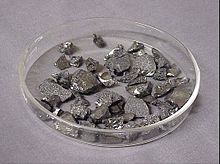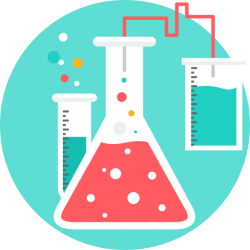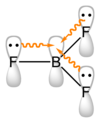WORKSHEET HERE
Boron is a chemical element with symbol B and atomic number 5. Produced entirely by cosmic ray spallation and supernovae and not by stellar nucleosynthesis, it is a low-abundance element in the Solar system and in the Earth’s crust.[13] Boron is concentrated on Earth by the water-solubility of its more common naturally occurring compounds, the borate minerals. These are mined industrially as evaporites, such as borax and kernite. The largest known boron deposits are in Turkey, the largest producer of boron minerals.
Elemental boron is a metalloid that is found in small amounts in meteoroids but chemically uncombined boron is not otherwise found naturally on Earth. Industrially, very pure boron is produced with difficulty because of refractory contamination by carbon or other elements. Several allotropes of boron exist: amorphous boron is a brown powder; crystalline boron is silvery to black, extremely hard (about 9.5 on the Mohs scale), and a poor electrical conductor at room temperature. The primary use of elemental boron is as boron filaments with applications similar to carbon fibers in some high-strength materials.
Boron is primarily used in chemical compounds. About half of all boron consumed globally is an additive in fiberglass for insulation and structural materials. The next leading use is in polymers and ceramics in high-strength, lightweight structural and refractory materials. Borosilicate glass is desired for its greater strength and thermal shock resistance than ordinary soda lime glass. Boron compounds are used as fertilizers in agriculture and in sodium perborate bleaches. A small amount of boron is used as a dopant in semiconductors, and reagent intermediates in the synthesis of organic fine chemicals. A few boron-containing organic pharmaceuticals are used or are in study. Natural boron is composed of two stable isotopes, one of which (boron-10) has a number of uses as a neutron-capturing agent.
In biology, borates have low toxicity in mammals (similar to table salt), but are more toxic to arthropods and are used as insecticides. Boric acid is mildly antimicrobial, and several natural boron-containing organic antibiotics are known.[14] Boron compounds play a strengthening role in the cell walls of all plants, making boron a necessary plant nutrient. There is no consensus on whether boron is an essential nutrient for mammals, including humans, although there is some evidence it supports bone health.
History
The word boron was coined from borax, the mineral from which it was isolated, by analogy with carbon, which boron resembles chemically.
Borax, its mineral form then known as tincal, glazes were used in China from AD 300, and some crude borax reached the West, where the Persian alchemist Jābir ibn Hayyān apparently mentioned it in AD 700. Marco Polo brought some glazes back to Italy in the 13th century. Agricola, around 1600, reports the use of borax as a flux in metallurgy. In 1777, boric acid was recognized in the hot springs (soffioni) near Florence, Italy, and became known as sal sedativum, with primarily medical uses. The rare mineral is called sassolite, which is found at Sasso, Italy. Sasso was the main source of European borax from 1827 to 1872, when American sources replaced it.[15][16] Boron compounds were relatively rarely used until the late 1800s when Francis Marion Smith‘s Pacific Coast Borax Company first popularized and produced them in volume at low cost.[17]
Boron was not recognized as an element until it was isolated by Sir Humphry Davy[9] and by Joseph Louis Gay-Lussac and Louis Jacques Thénard.[8] In 1808 Davy observed that electric current sent through a solution of borates produced a brown precipitate on one of the electrodes. In his subsequent experiments, he used potassium to reduce boric acid instead of electrolysis. He produced enough boron to confirm a new element and named the element boracium.[9] Gay-Lussac and Thénard used iron to reduce boric acid at high temperatures. By oxidizing boron with air, they showed that boric acid is an oxidation product of boron.[8][18] Jöns Jakob Berzelius identified boron as an element in 1824.[19] Pure boron was arguably first produced by the American chemist Ezekiel Weintraub in 1909.[20][21]
Preparation of elemental boron in the laboratory
The earliest routes to elemental boron involved the reduction of boric oxide with metals such as magnesium or aluminium. However, the product is almost always contaminated with borides of those metals. Pure boron can be prepared by reducing volatile boron halides with hydrogen at high temperatures. Ultrapure boron for use in the semiconductor industry is produced by the decomposition of diborane at high temperatures and then further purified with the zone melting or Czochralski processes.[23]
The production of boron compounds does not involve the formation of elemental boron, but exploits the convenient availability of borates.
Characteristics
Allotropes
Boron is similar to carbon in its capability to form stable covalently bonded molecular networks. Even nominally disordered (amorphous) boron contains regular boron icosahedra which are, however, bonded randomly to each other without long-range order.[24][25] Crystalline boron is a very hard, black material with a melting point of above 2000 °C. It forms four major polymorphs: α-rhombohedral and β-rhombohedral (α-R and β-R), γ and β-tetragonal (β-T); α-tetragonal phase also exists (α-T), but is very difficult to produce without significant contamination. Most of the phases are based on B12 icosahedra, but the γ-phase can be described as a rocksalt-type arrangement of the icosahedra and B2 atomic pairs.[26] It can be produced by compressing other boron phases to 12–20 GPa and heating to 1500–1800 °C; it remains stable after releasing the temperature and pressure. The T phase is produced at similar pressures, but higher temperatures of 1800–2200 °C. As to the α and β phases, they might both coexist at ambient conditions with the β phase being more stable.[26][27][28]Compressing boron above 160 GPa produces a boron phase with an as yet unknown structure, and this phase is a superconductor at temperatures 6–12 K.[29]Borospherene (fullerene-like B40) molecules) and borophene (proposed graphene-like structure) have been described in 2014.
Chemistry of the element
Elemental boron is rare and poorly studied because the pure material is extremely difficult to prepare. Most studies of “boron” involve samples that contain small amounts of carbon. The chemical behavior of boron resembles that of silicon more than aluminium. Crystalline boron is chemically inert and resistant to attack by boiling hydrofluoric or hydrochloric acid. When finely divided, it is attacked slowly by hot concentrated hydrogen peroxide, hot concentrated nitric acid, hot sulfuric acid or hot mixture of sulfuric and chromic acids.[21]
The rate of oxidation of boron depends on the crystallinity, particle size, purity and temperature. Boron does not react with air at room temperature, but at higher temperatures it burns to form boron trioxide:[38]
- 4 B + 3 O2 → 2 B2O3
Ball-and-stick model of tetraborate anion, [B4O5(OH)4]2−, as it occurs in crystalline borax, Na2[B4O5(OH)4]·8H2O. Boron atoms are pink, with bridging oxygens in red, and four hydroxyl hydrogens in white. Note two borons are trigonally bonded sp2 with no formal charge, while the other two borons are tetrahedrally bonded sp3, each carrying a formal charge of −1. The oxidation state of all borons is III. This mixture of boron coordination numbers and formal charges is characteristic of natural boron minerals.
Boron undergoes halogenation to give trihalides; for example,
- 2 B + 3 Br2 → 2 BBr3
The trichloride in practice is usually made from the oxide.[38]
Chemical compounds
Boron (III) trifluoridestructure, showing “empty” boron p orbital in pi-type coordinate covalent bonds
In the most familiar compounds, boron has the formal oxidation state III. These include oxides, sulfides, nitrides, and halides.[38]
The trihalides adopt a planar trigonal structure. These compounds are Lewis acids in that they readily form adducts with electron-pair donors, which are called Lewis bases. For example, fluoride (F−) and boron trifluoride (BF3) combined to give the tetrafluoroborate anion, BF4−. Boron trifluoride is used in the petrochemical industry as a catalyst. The halides react with water to form boric acid.[38]
Boron is found in nature on Earth entirely as various oxides of B(III), often associated with other elements. More than one hundred borate minerals contain boron in oxidation state +3. These minerals resemble silicates in some respect, although boron is often found not only in a tetrahedral coordination with oxygen, but also in a trigonal planar configuration. Unlike silicates, the boron minerals never contain boron with coordination number greater than four. A typical motif is exemplified by the tetraborate anions of the common mineral borax, shown at left. The formal negative charge of the tetrahedral borate center is balanced by metal cations in the minerals, such as the sodium (Na+) in borax.[38]
Boranes are chemical compounds of boron and hydrogen, with the generic formula of BxHy. These compounds do not occur in nature. Many of the boranes readily oxidise on contact with air, some violently. The parent member BH3 is called borane, but it is known only in the gaseous state, and dimerises to form diborane, B2H6. The larger boranes all consist of boron clusters that are polyhedral, some of which exist as isomers. For example, isomers of B20H26 are based on the fusion of two 10-atom clusters.
The most important boranes are diborane B2H6 and two of its pyrolysis products, pentaborane B5H9 and decaborane B10H14. A large number of anionic boron hydrides are known, e.g. [B12H12]2−.
The formal oxidation number in boranes is positive, and is based on the assumption that hydrogen is counted as −1 as in active metal hydrides. The mean oxidation number for the borons is then simply the ratio of hydrogen to boron in the molecule. For example, in diborane B2H6, the boron oxidation state is +3, but in decaborane B10H14, it is 7/5 or +1.4. In these compounds the oxidation state of boron is often not a whole number.
The boron nitrides are notable for the variety of structures that they adopt. They exhibit structures analogous to various allotropes of carbon, including graphite, diamond, and nanotubes. In the diamond-like structure, called cubic boron nitride (tradename Borazon), boron atoms exist in the tetrahedral structure of carbons atoms in diamond, but one in every four B-N bonds can be viewed as a coordinate covalent bond, wherein two electrons are donated by the nitrogen atom which acts as the Lewis base to a bond to the Lewis acidicboron(III) centre. Cubic boron nitride, among other applications, is used as an abrasive, as it has a hardness comparable with diamond (the two substances are able to produce scratches on each other). In the BN compound analogue of graphite, hexagonal boron nitride (h-BN), the positively charged boron and negatively charged nitrogen atoms in each plane lie adjacent to the oppositely charged atom in the next plane. Consequently, graphite and h-BN have very different properties, although both are lubricants, as these planes slip past each other easily. However, h-BN is a relatively poor electrical and thermal conductor in the planar directions.[39][40]





